I. Introduction
A. Overview of the Binturong 🐾
The Binturong, also known as the Bearcat, is a tree-dwelling carnivore found in Southeast Asia. It is the largest member of the Viverridae family, which includes civets and genets. The Binturong is a unique animal with distinctive features, making it an interesting animal to study.
B. Why the Binturong is an interesting animal to study 🤔
- Unique physical features 👀
The Binturong has several unique physical features that make it stand out. Its long, bushy tail is prehensile, allowing it to grip branches like an extra limb. The Binturong’s paws have sharp claws and pads with sweat glands, which provide it with a good grip while climbing. It also has a shaggy, black coat, which helps to protect it from insects and other pests.
- Fascinating behaviors 🤹♀️
The Binturong is primarily nocturnal and arboreal, spending most of its time in trees. It has a unique way of moving through the trees, using its prehensile tail and paws to grip branches while it climbs. The Binturong is also known for its distinctive vocalizations, including grunts, hisses, and purrs. These sounds are used to communicate with other Binturongs and to mark its territory.
- Ecological importance 🌿
As a tree-dwelling carnivore, the Binturong plays an important role in its ecosystem. It helps to control populations of small animals, such as rodents and birds, by hunting them for food. The Binturong also helps to disperse seeds as it moves through the trees, aiding in the regeneration of the forest.
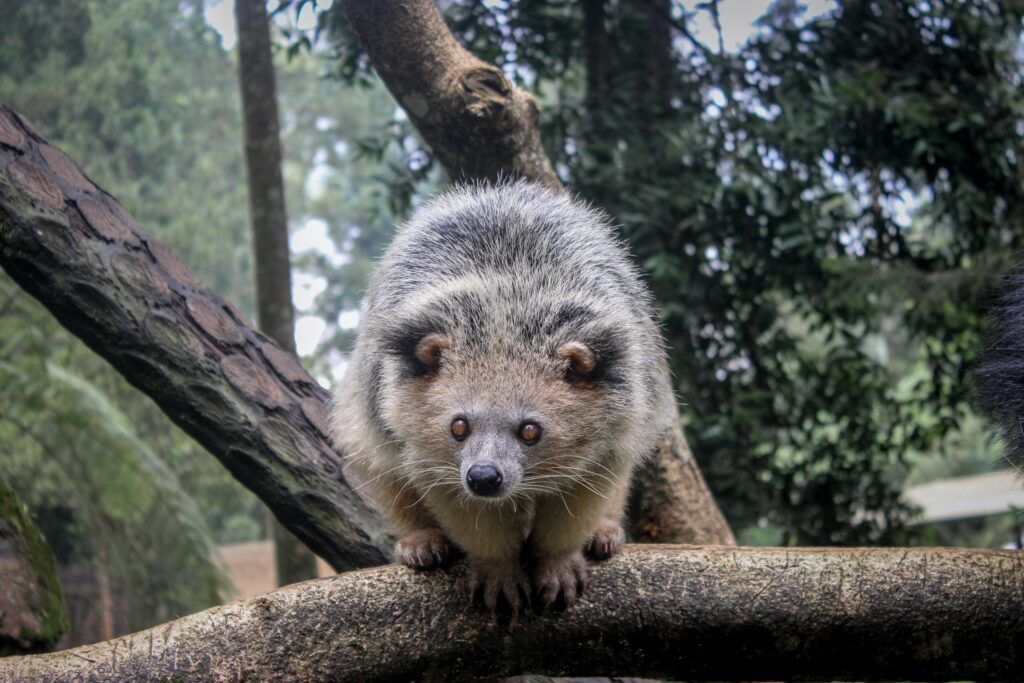
C. Why it is known as bearcat?
The binturong is known as the bearcat because of its physical appearance and behavior, which resembles a mix of a bear and a cat. Although it is not closely related to either bears or cats, the binturong has a thick, shaggy coat of fur like a bear, and its face and body shape resemble that of a cat.
Additionally, the binturong is a skilled climber and spends much of its time in trees, like many cat species. It also has retractable claws, another characteristic commonly associated with cats.
II. Taxonomy and Distribution
A. 🌳 Scientific classification of Binturong
The Binturong, also known as the Asian Bearcat, is a tree-dwelling carnivore that belongs to the Viverridae family. Its scientific name is Arctictis binturong. The Binturong is the only species in the Arctictis genus.
Kingdom: Animalia
Phylum: Chordata
Class: Mammalia
Order: Carnivora
Family: Viverridae
Genus: Arctictis
Species: Arctictis binturong
B. 🏞️ Habitat and distribution range of Binturong
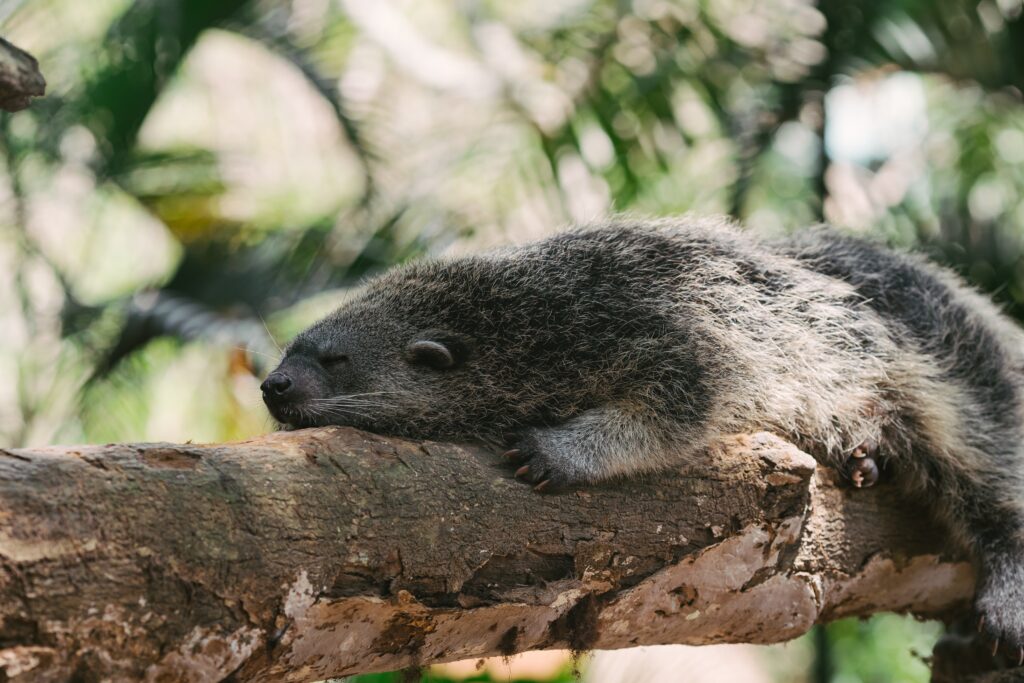
Binturongs are native to Southeast Asia and can be found in the forests of Bangladesh, Bhutan, Cambodia, China, India, Indonesia, Laos, Malaysia, Myanmar, Nepal, the Philippines, Thailand, and Vietnam. They prefer to live in dense forests and spend most of their time in trees.
Binturongs are well-adapted to living in the canopy and have a prehensile tail that helps them grip branches. They also have strong claws that allow them to climb and descend trees headfirst.
C. 🐾 Endangered status and conservation efforts for Binturong
The Binturong is listed as a vulnerable species by the International Union for Conservation of Nature (IUCN). The primary threats to the Binturong’s survival are habitat loss and hunting for its meat and fur.
Conservation efforts for the Binturong include protected areas, such as national parks and wildlife reserves, where they can live without being disturbed by human activities. In addition, captive breeding programs have been established in zoos and other institutions to help maintain the Binturong population.
Awareness campaigns have also been launched to educate local communities and raise awareness about the importance of conserving this species. The Binturong’s unique ecological role as a seed disperser has been highlighted, which can help to promote the conservation of its habitat and the species itself.
III. Physical Characteristics
A. Size and Weight of Binturong
The Binturong, also known as the bearcat, is a large tree-dwelling mammal found in the forests of Southeast Asia. Adult Binturongs can grow up to 3 feet in length, with a tail that adds another 2 feet to their total length. They weigh anywhere between 25-40 pounds, with males being larger than females on average.
B. Unique Physical Features of Binturong
The Binturong has several unique physical features that distinguish it from other mammals. Firstly, it has shaggy black fur that is thick and coarse, providing insulation in the cool, damp forests it inhabits. Their fur also has a distinct odor that is often described as smelling like popcorn or buttered popcorn. This odor is produced by their scent glands and is used to mark their territory.
Another unique feature of the Binturong is their prehensile tail. This means that their tail is strong and flexible, allowing them to grasp and hold onto branches as they climb and move through the trees. Their paws are also adapted for climbing, with long claws that can grasp onto bark and other rough surfaces.
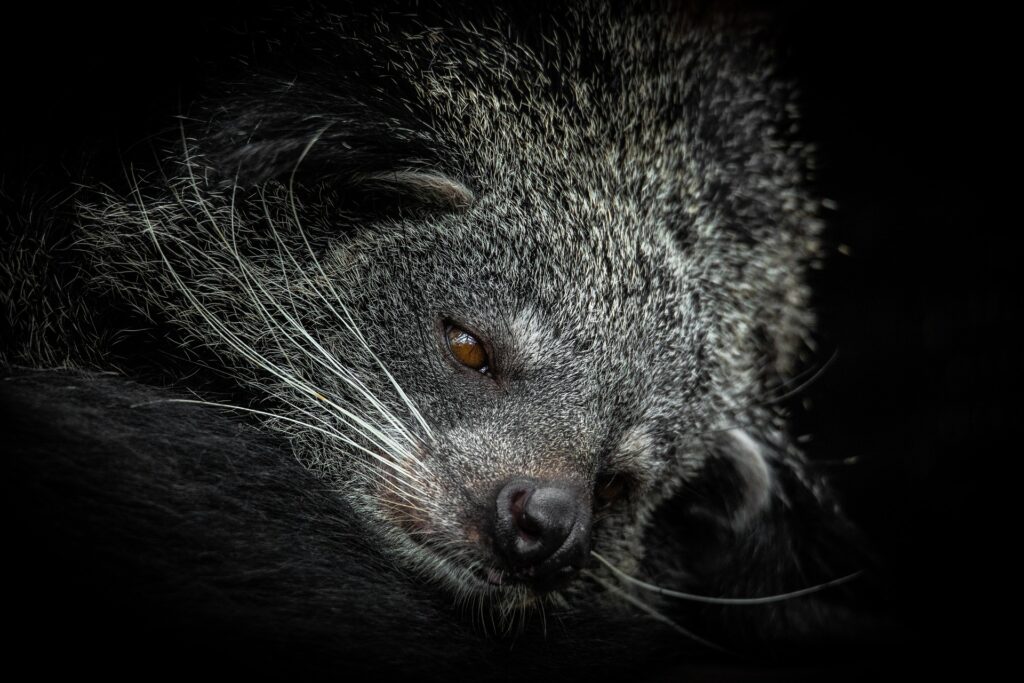
C. Differences between Males and Females
Male Binturongs are typically larger than females, with longer and thicker tails. Males also have a larger head and more prominent canines than females. Additionally, males have a stronger odor produced by their scent glands, which they use to attract females during mating season.
D. Adaptations of Binturong to its Habitat
Binturongs are well-adapted to their forest habitat, where they spend most of their time in the trees. Their prehensile tail, strong claws, and muscular limbs allow them to move easily through the canopy. Their thick, shaggy fur provides insulation from the cool, damp environment, and their keen sense of smell helps them locate prey and navigate their surroundings.
One particularly interesting adaptation of the Binturong is their ability to eat and digest a variety of foods, including fruits, insects, small mammals, and even carrion. This diverse diet allows them to survive in a habitat with fluctuating food availability.
IV. Binturong’s Special Powers
A. Climbing Ability 🌳
The Binturong is an expert climber, using its prehensile tail to navigate the dense canopy of the rainforest. Its tail is approximately 2.5 feet long and can grip branches like an extra hand, providing stability and balance as it moves through the trees. The Binturong also has sharp claws that allow it to cling to bark and climb vertically up tree trunks. Its agile and nimble movements enable it to reach fruits and prey that are inaccessible to other animals.
B. Scent Marking Behavior 👃
Another unique ability of the Binturong is its strong odor, which comes from a musky scent gland located near its tail. This gland secretes a pungent odor that the Binturong uses to mark its territory and communicate with other animals. Binturongs will rub their scent glands on trees and other objects to leave their mark and communicate their presence. Their scent is so potent that it has been described as smelling like buttered popcorn!
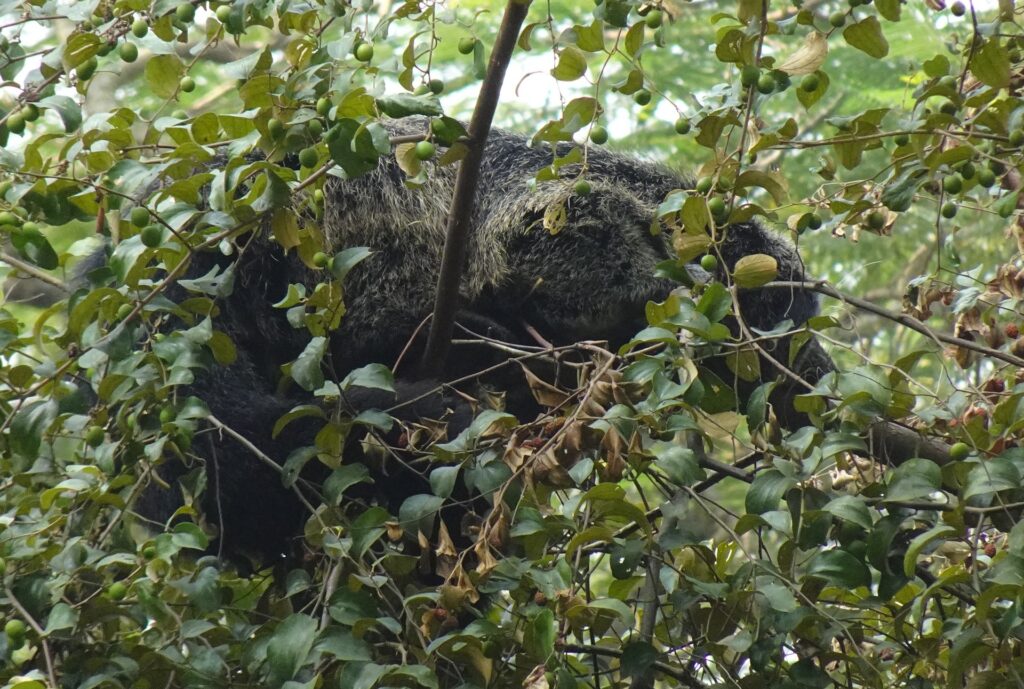
C. Importance of Binturong’s Special Powers in its Ecosystem 🌍
The Binturong’s special powers are crucial to the health of its ecosystem. Its climbing ability allows it to disperse the seeds of fruits and plants throughout the rainforest, promoting plant diversity and growth. The Binturong’s scent marking behavior also plays an important role in maintaining balance in the ecosystem. By marking its territory, the Binturong helps to prevent conflicts with other animals over resources and establish clear boundaries.
D. Significance of Binturong’s Special Powers in Traditional Medicine 💊
In traditional medicine, the Binturong’s scent glands are believed to have healing properties and are used in remedies for various ailments. The glands are said to have anti-inflammatory and anti-bacterial properties and have been used to treat conditions such as rheumatism, skin infections, and respiratory problems. However, the use of Binturong products in traditional medicine has contributed to their decline in the wild, as they are often hunted for their glands and meat.
ALSO READ: The Aye Aye: A Madagascar’s Fascinating Primate!
V. Behavior and Lifestyle
A. Binturong’s Social Life and Behavior 🐻
The binturong, also known as the bearcat, is a tree-dwelling carnivore that is native to Southeast Asia. Binturongs are solitary animals and are mostly active at night, spending their days sleeping in the trees. However, they do have a social hierarchy within their territories, with males being dominant over females.
Binturongs mark their territory with a scent produced by anal glands, and will engage in scent marking and vocalizations to communicate with other binturongs. They are also known to be playful and curious, and will investigate new objects in their environment.
B. Hunting and Feeding Behavior of Binturong 🍴
Binturongs are omnivores, and their diet consists of a variety of fruits, leaves, insects, small mammals, birds, and eggs. They have a unique adaptation in their digestive system that allows them to digest tough plant material, such as leaves and bark.
Binturongs are skilled climbers and will use their long prehensile tails to navigate through the trees. They will hunt by ambush or by climbing trees to catch their prey. Despite their carnivorous nature, they have a relatively low metabolic rate and can survive for long periods without food.
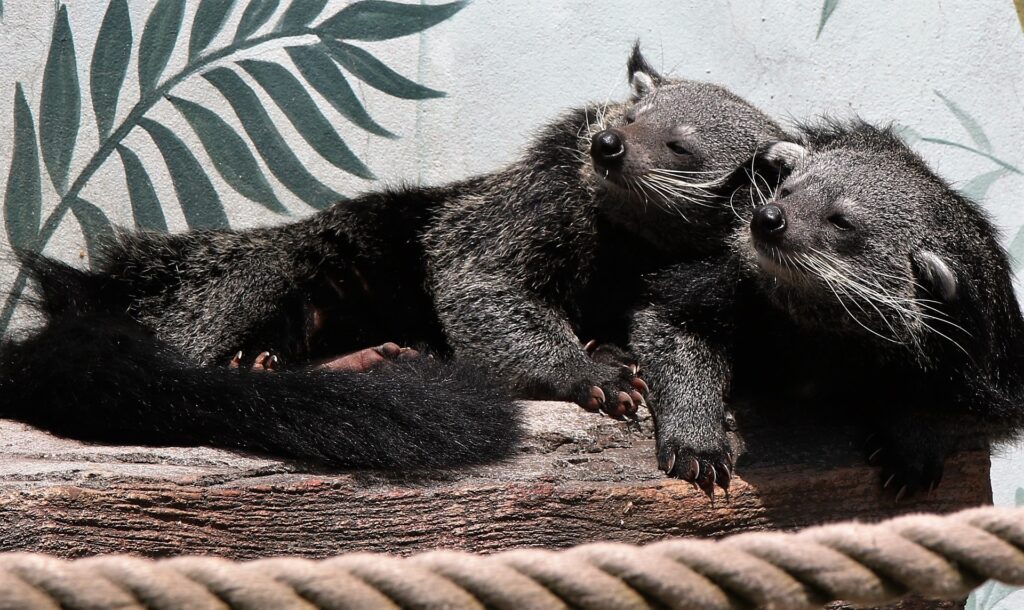
C. Reproduction and Parenting of Binturong 👨👩👧👦
Binturongs are sexually mature at around two years of age, and breeding occurs throughout the year. Females have a gestation period of around 90-92 days and will give birth to one or two offspring, known as kits.
The kits are born with their eyes closed and are fully dependent on their mothers for the first few months of their lives. Binturong mothers are known for their dedicated parenting, and will carry their young on their backs while they forage for food.
D. Communication Methods of Binturong 🗣️
Binturongs communicate with each other through a variety of methods. They use vocalizations such as grunts, growls, and hisses, as well as scent marking to communicate with other binturongs.
They are also known to use their tails to signal their mood to other binturongs, with a curled tail indicating a relaxed and content binturong, and a straight tail indicating aggression or fear.
VI. Relationship with Humans
A. Role of Binturong in Cultural Traditions and Folklore
Binturongs have played an important role in the cultural traditions and folklore of Southeast Asia. In some parts of Indonesia, binturongs are believed to have spiritual powers and are considered to be guardians of the forest. According to a legend in the Philippines, binturongs were once known for their ability to predict natural disasters, and people would listen for their calls to determine when a disaster was coming. In Malaysia, binturongs are said to bring good luck and are sometimes kept as pets.
B. Captivity and Usage of Binturongs in Entertainment Industry
Unfortunately, binturongs are also exploited for human entertainment. They are often kept in captivity and used for purposes such as circuses, zoos, and photo opportunities. This kind of captivity and usage of binturongs is inhumane and is a major challenge for conservation efforts.

C. Conflicts Between Humans and Binturongs and Conservation Challenges
Binturongs have been known to raid fruit crops and cause damage to human property. As a result, conflicts between humans and binturongs arise. Moreover, habitat loss due to deforestation and human activities also pose significant threats to the survival of binturongs in the wild. As a result, there is a need for more conservation efforts to protect binturongs from extinction.
D. Binturongs as Pets
Binturongs are sometimes kept as pets, despite being wild animals. However, it is important to remember that keeping a wild animal as a pet is not only illegal in some areas but also very dangerous for the animal and the human. Binturongs require a specific diet, habitat, and care that most people cannot provide, leading to stress and suffering for the animal. It is best to appreciate these fascinating creatures from a distance, rather than trying to domesticate them.
VII. Research and Conservation Efforts
A. Research studies on Binturongs
Several research studies have been conducted on binturongs to better understand their ecology, behavior, and conservation needs. In 2018, a study conducted in the Tabin Wildlife Reserve in Sabah, Malaysia, investigated the habitat preferences of binturongs and their use of natural cavities as den sites. The study found that binturongs preferred habitats with tall trees and dense canopy cover, and that the availability of natural cavities played a crucial role in their den selection. Another study conducted in Cambodia in 2019 investigated the genetic diversity and population structure of binturongs in the country. The study found that binturongs in Cambodia had low genetic diversity, indicating that they may be vulnerable to genetic problems and local extinction.
B. Conservation efforts to protect Binturongs and their habitat
Binturongs face several threats, including habitat loss, hunting, and illegal trade. To address these threats, several conservation efforts have been initiated to protect binturongs and their habitat. The Binturong Conservation Project, for example, is a conservation initiative launched in 2011 by the Zoological Society of London and the Sintang Orangutan Center in Indonesia. The project aims to protect binturongs and their habitat in the West Kalimantan region of Indonesia by working with local communities to reduce habitat destruction and poaching, and by conducting research on binturong ecology and behavior.
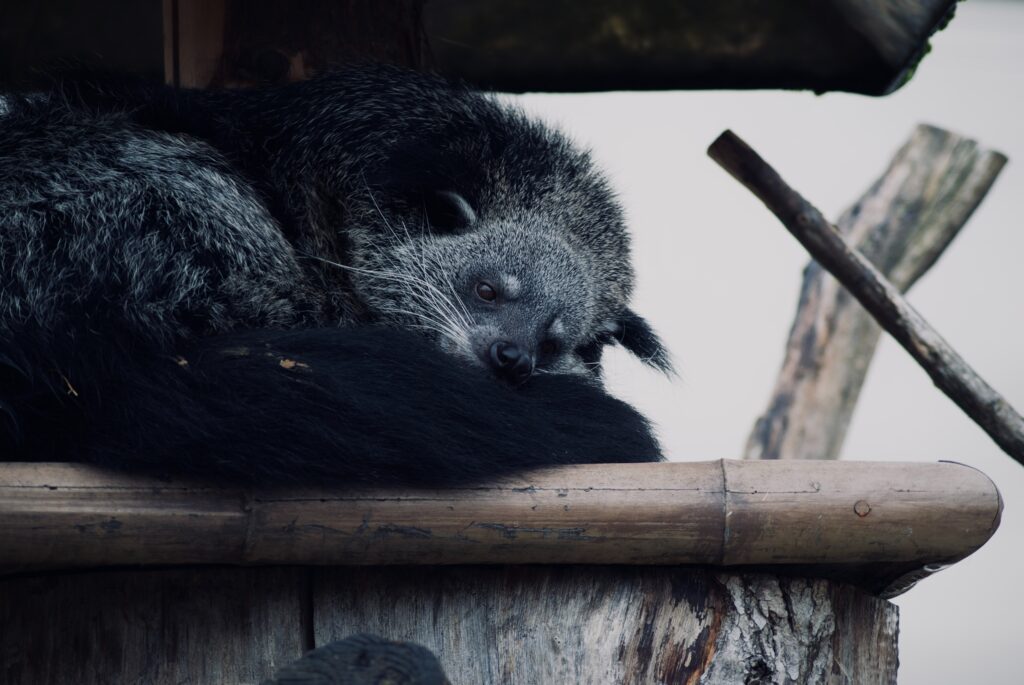
C. Successes and challenges of conservation efforts
Conservation efforts have had some successes in protecting binturongs and their habitat. For example, the Binturong Conservation Project has successfully reduced hunting and habitat destruction in the West Kalimantan region of Indonesia. However, challenges remain, including the difficulty of enforcing wildlife protection laws, the lack of funding and resources for conservation initiatives, and the need for more research on binturong ecology and behavior.
D. Role of zoos in Binturong conservation
Zoos play an important role in binturong conservation by providing a safe and stable environment for binturongs, educating the public about the importance of these species, and conducting research on their ecology and behavior. The San Diego Zoo, for example, has a successful binturong breeding program and conducts research on binturong behavior and physiology. Zoos also work together to coordinate breeding programs and share information on binturong conservation.
VIII. Conclusion
In conclusion, we hope you’ve enjoyed getting to know the binturong, one of the most interesting animals you’ve probably never heard of before! From its endearing personality to its popcorn-scented aroma, this arboreal mammal is a true gem of the animal kingdom.
While the binturong may not be in immediate danger of extinction, we must still take action to protect its habitat and ensure its survival in the wild. By raising awareness and supporting conservation efforts, we can help preserve this incredible creature for generations to come.

And if you’re lucky enough to spot a binturong in the wild or at a zoo, be sure to take a moment to observe and appreciate its unique qualities. These fascinating animals are truly one-of-a-kind and deserve all the attention and admiration they can get!
🌳🐾❤️🐻🦨👀
As we wrap up this blog on the binturong, we want to thank you for joining us on this journey and learning more about this amazing animal. Keep exploring the world of wildlife and never stop being curious about the many wonders of our planet. Who knows, you may just discover your new favorite animal!
Also Read: The binturong – A fierce, canopy-dwelling carnivore!

This page is extraordinary. The magnificent data uncovers the proprietor’s responsibility. I’m stunned and sit tight for additional such marvelous posts.
I have been browsing online more than three hours today yet I never found any interesting article like yours It is pretty worth enough for me In my view if all website owners and bloggers made good content as you did the internet will be a lot more useful than ever before
I have been surfing online more than 3 hours today yet I never found any interesting article like yours It is pretty worth enough for me In my opinion if all web owners and bloggers made good content as you did the web will be much more useful than ever before